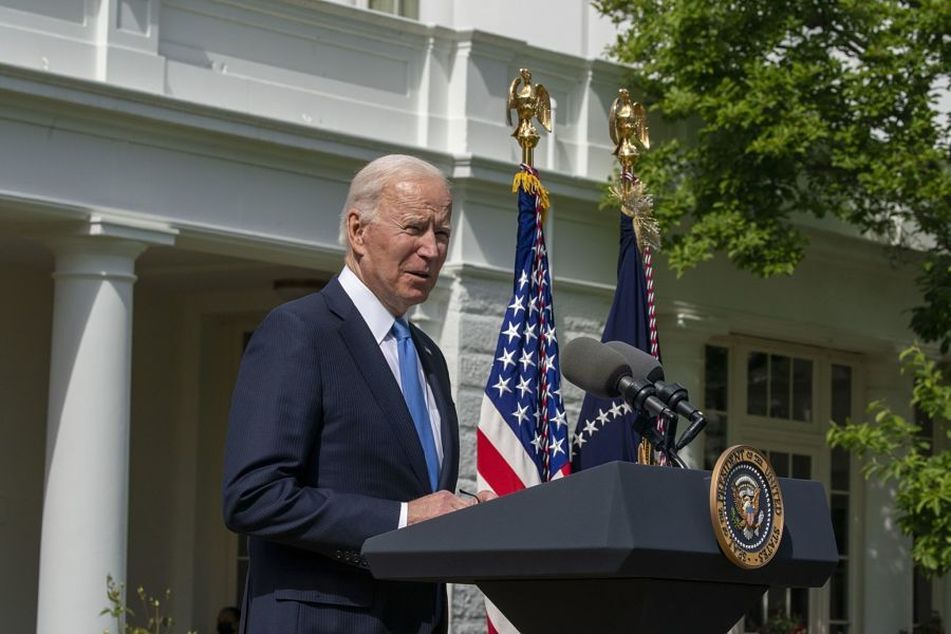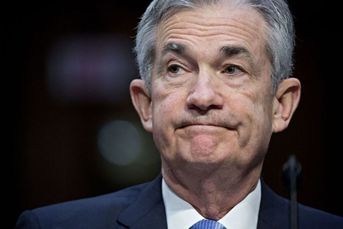Biden’s budget would raise annual spending to $6 billion

The budget will assume the increase in the top capital gains tax rate to 43.4% that Biden has proposed will be effective retroactive to late April.
President Joe Biden is set to unveil a budget that would increase federal spending to $6 trillion in the coming fiscal year, with annual deficits of more than $1.3 trillion over the next decade, according to documents cited by the New York Times.
The proposal, set to be publicly released on Friday, offers a full accounting of Biden’s previously disclosed plans for trillions of dollars in new taxes and government spending while also revealing for the first time how the administration believes inflation, employment, and economic growth would be affected by enacting his agenda.
Spending would rise to $8.2 trillion by 2031, while the federal debt would rise to 117% of gross domestic product over the next decade.
Like most presidential budgets, the documents released Friday will be largely aspirational. Democrats hold only narrow majorities in the House and Senate, and lawmakers from both sides of the aisle have made clear they’re unlikely to adopt Biden’s proposals in full.
Still, the documents will offer the first expansive look at the entirety of Biden’s effort to dramatically boost the size and scope of the federal government, and a preview of how the White House assesses the health of and prospects for an economy emerging from an unprecedented global pandemic. The administration predicts the economy will grow at just under 2% per year for most of the decade once inflation is factored in.
GOP lawmakers already are objecting. Sen. Mike Braun of Indiana said on Bloomberg Television that Biden’s $6 trillion plan is “unbelievable” and “crazy.”
INFLATION CONTAINED
Goldman Sachs Group Inc. analysts said in a note to clients that the budget would be made public at 1:30 p.m. in New York on Friday and questioned the timing.
“The White House has decided to release what is arguably the most important policy document of the year on a Friday afternoon before a three-day weekend at the start of a congressional recess, when it is likely to receive little attention, rather than the traditional Monday morning release when Congress is in session,” they wrote.
They predicted Congress would ultimately approve new spending and tax breaks of about $3 trillion over 10 years, with half of that offset by tax increases, mostly on capital gains and corporations.
The administration makes clear it does not share fears espoused by some on Wall Street of rapid inflation, predicting consumer prices would never rise faster than 2.3% per year. And the budget predicts a quickly rebounding labor market, with unemployment falling to 4.1% by next year and remaining below 4% over the rest of the coming decade.
A spokesman for the Office of Management and Budget declined to comment on the Times report. White House Press Secretary Jen Psaki declined to comment on the accuracy of the figures, but defended the expected size of the president’s budget proposal.
“What the budget will reflect is he’s going to continue to deliver on his priorities of doing more work to get the pandemic under control, putting people back to work, and those proposals — the American Jobs Plan, the American Rescue Plan, the American Families Plan — will put us on better financial footing over time,” Psaki said.
The budget release builds on a $1.52 trillion discretionary spending request — that is, excluding required spending such as Social Security — released by the White House in April that saw the president call for a 15.9% increase in domestic outlays, led by significant new investments in education and health programs.
That earlier document left out Biden’s $2.25 trillion jobs and infrastructure proposal and the $1.8 trillion American Families Plan, as well as the tax increases on corporations and the wealthy that the White House has championed to offset the cost.
TAX PLANS
Those spending proposals are included in the full budget proposal released Friday, which is also expected to detail specific program spending requests as well as administration estimates about GDP growth and interest rates.
The Treasury Department will separately release a detailed list of Biden’s tax proposals — in a document colloquially known as the “green book” — that effectively serves as the revenue side of the ledger.
The budget will assume that the increase in the capital gains tax rate that Biden has proposed will be effective retroactive to late April, a person familiar with the decision said. Biden wants to raise the top rate for households earning more than $1 million to 43.4% — a number that includes an existing 3.8% surtax to help pay for the Affordable Care Act — from 23.8%.
The increase, regardless of when it takes effect, would need approval from Congress, something that’s unlikely given criticism of the proposal from congressional Democrats such as Sen. Mark Warner of Virginia. The Wall Street Journal reported on the budget’s handling of the capital gains tax increase earlier Thursday.
The budget document only accounts for legislation Biden is pursuing this year, leaving out major proposals like targeting prescription drug prices and a public health care option that the president has said will be major legislative targets later in his presidency.
The delivery of the budget kicks off a crucial and frenetic period of activity on Capitol Hill that could determine the fate of Biden’s legacy-defining legislative push.
[More: Biden tax proposal draws ire from financial advisers]
LEGISLATIVE PROCESS
The House and Senate can begin writing and voting on the 12 annual spending bills needed to keep the government open after the Oct. 1 start of the new fiscal year. Negotiations over those bills — which will require bipartisan support in the Senate — have already hit rocky terrain.
Biden’s proposal for $753 billion in defense spending in the upcoming fiscal year — a 1.7% increase — has prompted divisions within the Democratic Party, with progressives pushing for cuts and hawks seeking higher levels. It’s also prompted objections from Senate Republicans, who want defense increases to equal those for social programs.
The delivery of the president’s budget also clears the way for the House and Senate to begin working on their own 2022 outline. That, in turn, will unlock a fast-track process that can allow Democrats to pass large portions of Biden’s infrastructure, tax plan and social spending along party lines. Democrats are using the threat of going it alone to try to wring more concessions from Republicans in infrastructure talks this week.
A group of Republican senators publicly revealed a $928 billion counteroffer on infrastructure on Thursday, but the plan includes only about $257 billion in new federal spending beyond what Congress already was expected to enact, and is more than $1 trillion short of Biden’s latest proposal.
The congressional budget legislation would contain detailed instructions for one or more follow-on bills implementing the tax increases, tax credits and spending increases. The committees are expected to act in June, regardless of whether the White House is able to come to a deal on physical infrastructure with Senate Republicans.
Both processes will be colored by the always intense political debate over federal spending, and Friday’s release is expected to kick off a familiar cycle of Democrats highlighting ways in which new government programs can promote economic growth while Republicans warn of the dangers of federal debt.
GROWING DEBT
The country’s total debt held by the public will grow to about 107% of gross domestic product in the next decade from 102% this year, according to the Congressional Budget Office. Fiscal hawks worry that the acceleration, tied with higher interest rates, will increase the country’s debt payments and make it a less desirable investment destination. Biden’s budget shows that payments on the national debt would double as a share of the economy between 2022 and 2031.
The White House, for its part, will likely look to focus attention on the budget’s estimates for how many millions of new jobs the president’s proposals would create — the first time the administration has offered concrete employment projections for its plans.
An employment surge would be a welcome respite for a labor market that’s still down 8.2 million jobs since February 2020, before the coronavirus pandemic. Most of those are in the service sector, including hospitality and restaurants.
Those payrolls have increased in recent months as the economy reopens across the country and Covid-19 restrictions ease with increased vaccinations. But some companies have complained that unemployment benefits are keeping workers from applying to jobs. Economists cite other concerns as well, including child care and health concerns.
The release of the green book — which was eschewed by the Trump administration — is also likely to provide political fodder in the coming weeks. The document will provide the greatest detail to date on many of the proposals — including a global minimum levy, taxing capital gains at death and closing the carried interest tax break — that Biden has already outlined in his American Jobs Plan and American Families Plan. It also outlines the amount of revenue the Treasury Department expects those changes would produce.
HEALTH CARE SPENDING
The president’s critics are likely to highlight the fact that by Biden’s own projections, within a decade the federal government would begin collecting more tax revenue as a share of the economy than at any point since the Clinton administration.
But Treasury Secretary Janet Yellen told lawmakers on Thursday that Biden’s spending plan represents a “fiscally responsible” approach.
“The president’s proposal, you’ll see, will have a temporary period of spending and permanent increases that beyond the budget window will result in lower deficits and more tax revenue to support those expenditures,” Yellen said while testifying during a House Appropriations subcommittee’s virtual hearing.
The green book will detail key tax credit proposals that Democratic lawmakers see as crucial policies to campaign on during the 2022 midterms, including an expansion of the child tax credit and benefits for green energy and electric vehicles.
The document will serve as the basis for congressional Democrats to begin turning Biden’s agenda into legislation. House Ways and Means Chairman Richard Neal and Senate Finance Committee Ron Wyden have already begun sifting through the president’s broad outlines and are preparing to move legislation later this year.
But the biggest political controversy may stem from what Biden omits from his budget release on Friday.
The request won’t incorporate some key campaign pledges, including enactment of an Affordable Care Act public option, lowering of the Medicare age or allowing Medicare to negotiate drug prices. That omission has drawn the ire of some progressive Democrats, who urged the president to prioritize health care issues early on in his administration.
But the documents obtained by the Times show that the White House included language asking Congress to allow Americans as young as 60 to enroll in Medicare and to pursue legislation reducing federal spending on prescription drugs. Biden also endorses expanding Medicare to cover dental, vision, and hearing services.
Congressional leaders are now eyeing 2022 as a chance to use the budget reconciliation process to make these changes before Democrats potentially lose control of one or both chambers of Congress in the 2022 midterms.
Learn more about reprints and licensing for this article.








